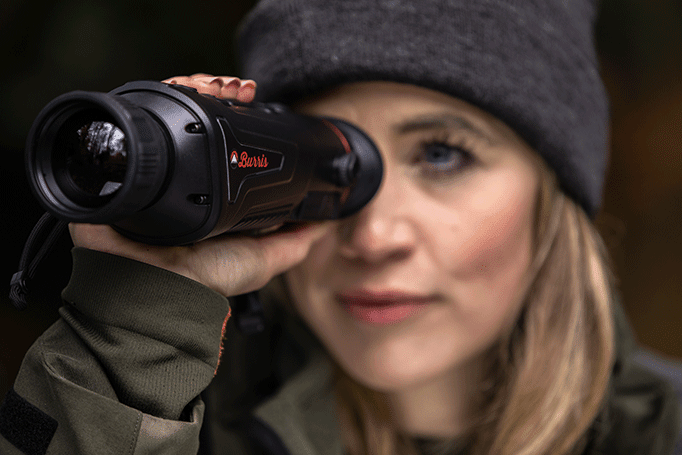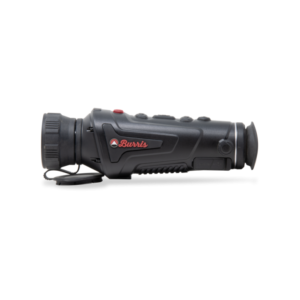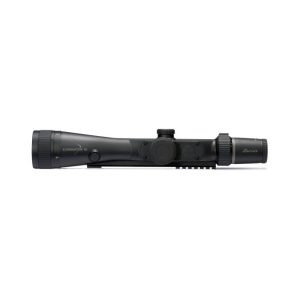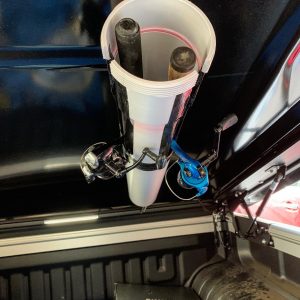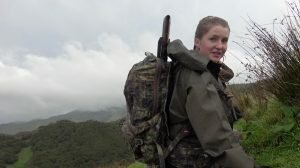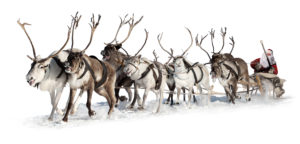Earlier this year, we had an opportunity to test out the brand new Burris Thermal Handheld (BTH 35). What we discovered was a rip snorting thermal optic device that turns up the heat on night shooting and lets you own the night. Or as we like to say, it helps you hunt when you can’t see shit!
It wasn’t too long ago that thermal optics and night vision were exclusively the realm of military crack teams, with the hefty price tag keeping them out of the hands of all but the most enthusiastic civilians. And while they are still not exactly cheap, advances in technology have brought the price down to where they’re comparable to some of the higher-end rifle scopes or spotting scopes.
As the name suggests, the BTH35 is a lightweight handheld device that lets you hot track targets up to 750 yards away. It has five colour palettes (white hot, black hot, iron red, blue hot and red hot), a 35mm objective, and a zoom function that provides up to 9.2 x magnification. The real time wifi connection also lets you both control and record the device from your mobile phone.
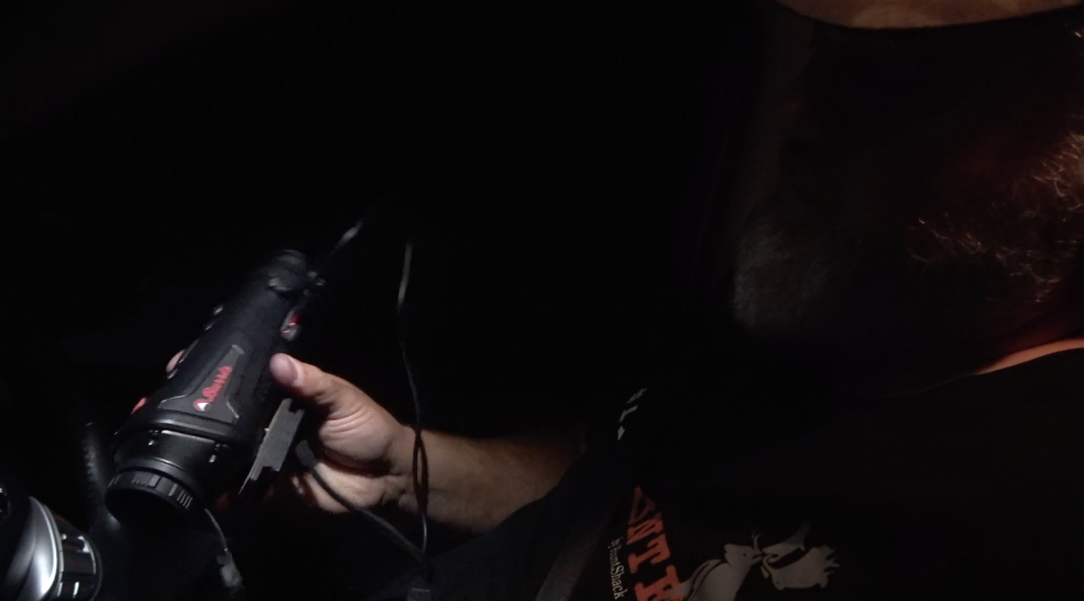
But how does it actually perform?
Superman vision
When it comes to seeing in the dark, the Burris BTH35 definitely owns the night. In fact, the first time I used it, I felt like Superman with x-ray vision! Admittedly, I was standing on our balcony in suburban Hobart and pointing it at the neighbour’s house. I didn’t really expect to see anything, so was surprised to see the faint outline of a heat signature through their thick, brick walls. Feeling a bit too much like a creepy voyeur, I averted my gaze and instead focused on our backyard. Within seconds, I could make out the individual body shapes of our hens in their coop (as well as that crazy chook that insists on roosting in a tree). I then panned across to watch our dogs running around like lunatics. I could even make out a ring-tail possum and her baby nesting in some nearby bushes.
Yet, it was the first time we took it to the farm that it really came into its own.
There’s a paddock right out the front of the farmhouse that has a small dam on it. We know the wallabies love to hang out there because they’ve decimated the pasture, and leave plenty of poo as evidence that they’ve been there. But being so close to the house, they also have the advantage of hearing us coming so every time we head out shooting, they are the first ones to flee to safety.
Standing in the yard looking directly at the paddock, I couldn’t see anything with my naked eye. But the minute I put the Burris Thermal to my eye, I could see dozens of the buggers eating my grass. I grabbed my trusty Tikka .223 and got a few head shots off before they even realised where the sound was coming from.
In Season 1 of I Am Hunter, which airs on MyOutdoorTV, the girls and I put the Burris Thermal through its paces on a crop protection hunt for possums and wallabies.
Good old dad really upped his game as spotter that night! In addition to my trusty spotlight, I was able to scan the trees with the Burris Thermal, spotting their heat signatures first before lighting them up for the girls to shoot.
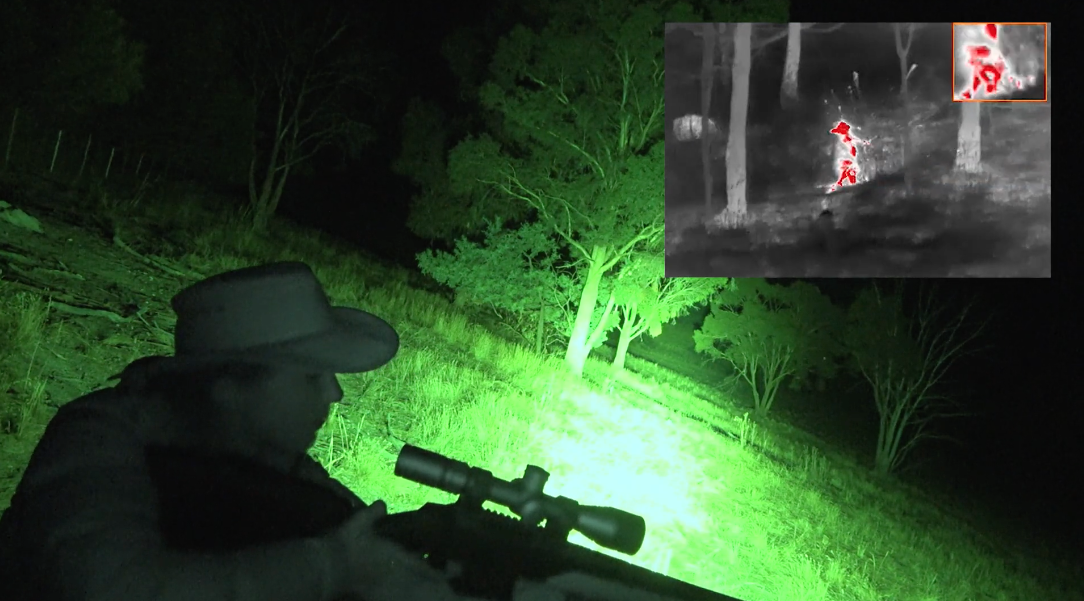
Below, I have outlined some of the key pros and cons of the Burris Thermal devices. However, I just want to provide a disclaimer that many of these benefits raise important questions about ethics and legality, which I will cover off on later.
Pros
Crop protection hunting, like other forms of pest control and wildlife management, is all about population control and the Burris Thermal detects animals that cannot be seen with the naked eye, or even in the powerful beam of a spotlight. This, in turn, leads to more successful culls and a reduction of pest animals in the area.
One of the most important safety aspects of hunting is correct target identification – knowing exactly what it is that you are shooting at. The Burris Thermal provides a clear image of the animal’s heat signature, which drastically reduces your chances of shooting the wrong thing. This is vitally important anywhere, but especially when you’re shooting on farmland. The last thing you want to do is accidentally shoot the farmer’s livestock. The Burris Thermal makes it easy to tell whether you have a possum, rabbit, wallaby or sheep in your sights.
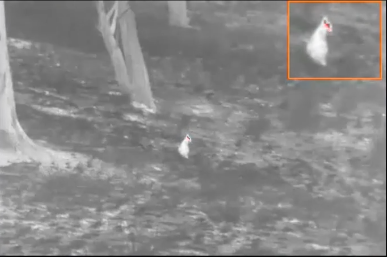
Using a thermal device definitely makes it easier to see livestock and farm infrastructure in the background, which can only increase the safety aspects of hunting on private farmland – and avoid any costly mistakes that will put you at odds with the farmer.
In terms of functionality, the device itself is really simple to use. You can adjust the contrast and brightness with the push of a button, and switch between the different colour palettes. It took me a bit to figure out the zoom function, but I put that more down to user error than design error!
I love the fact that you can watch all the action in real time on your phone and record your shots. This enabled us to get some fantastic footage for the TV show.
It’s lightweight and fits nicely in the palm of your hand and can be recharged with a USB cord.
The thermal sensors are so good that it can even pick up the heat signature from drops of blood, or the warmth left from an animal’s footprint. This means you could also use it to help track an injured animal.
Cons
Paraphrasing Newton himself, often positives have an equal and opposite negative. For instance, while the Burris Thermal can detect even the most hard to see animal hiding in the trees and bushes, that doesn’t necessarily mean you’re going to be able to shoot it.
One of the things we noticed while using it in the field is that I could clearly see where the animal was in the Burris Thermal, but the girls could see they didn’t have a clear shot. That’s because the thermal image doesn’t always show what is in front of the animal, which means you could have branches, leaves and bushes directly in your trajectory.
We were hunting in a group, with me holding the Burris Thermal and the girls doing the actual shooting. The handheld version would be a lot more cumbersome to use if you were hunting alone, as you would need to spot something with the Thermal and then switch to looking through the scope. However, this could be alleviated by using the Burris Thermal Scope.
Taking the above into consideration, the thermal is also an artificial light, which means switching between that and traditional optics can take some time for your eyes to adjust.
It is also yet another thing to carry with you while hunting. This is fine when crop protection hunting from a vehicle, but if hunting on foot, it’s additional weight you may not appreciate after a few kilometres.
Ethics and legality
Earlier, I mentioned that many of these pros (and cons) raise important questions about hunting ethics and legality.
For example, there are some purists who believe that any technology at all gives you an unfair advantage over an animal, and therefore shouldn’t be used.
Whether this true or not is open for interpretation. Just remember, it wasn’t that long ago that these same ethics questions were being asked about rifle scopes, and they are now seen as standard hunting tools.
It also comes down to how you view the advantage and disadvantage scale between hunter and quarry. Animals have more enhanced natural instincts than humans. They can hear better, see better, smell better and run faster. Many possess natural camouflage, as well as sharp teeth, claws and/or horns/antlers. Humans, on the other hand, possess a logical brain, which allows us to create and fashion tools, like the Burris Thermal, to compensate for our slower natural reflexes. Unless you are hunting with your hands and teeth, or using a spear, we all use some kind of technology to our advantage.
As with most hunting ethics, it is more important to take other contributing factors into consideration.
For example, what are you primarily trying to achieve through your hunting?
If you are hunting for meat and trophies, it’s most likely you would act according to the etiquette of fair chase hunting.
The main goal of fair chase hunting is to pit yourself against nature; to test your skills; and to ensure the animal has equal chance to see you and flee to safety (ie. the fair chase element).
On the other hand, the main goal of a management or cull hunt is population control – ie. you are seeking to find and kill as many target species as possible in the allotted hunting time. In this scenario, a humane kill trumps fair chase as the primary concern.
We use the Burris Thermal to complement our pest control activities because, used in conjunction with a powerful spotlight, it allows us to achieve maximum success in a shorter amount of time.
However, I would personally not want to use it at all on a spot and stalk hunt, where fair chase hunting was my primary goal.
There’s an argument to be had that the thermal imaging sensors might allow me to better track a wounded animal – and therefore increase my chances of a humane kill. But the flip side of that is that, simply having it on your person while spot and stalk hunting both increases your temptation to use it in an unethical manner, and opens you up to interpretation of the laws if searched by a wildlife officer.
There’s general consensus both among the hunting community and wildlife officers that thermal devices could make it easier for poachers to operate. For that reason, many of the states that view deer as a game animal categorise thermal imaging devices as spotlights. This means they would not be allowed while hunting game animals, and may require a permit to use.
This is certainly the case in Victoria and NSW, where a spotlight is defined as any source of artificial light, infrared device, night vision or heat detecting device. And while Tasmania has no current laws around hunting with a thermal device, there are plans to open it up for public consultation.
At the end of the day, like many things in hunting, thermal imaging devices have their place. They can be an excellent tool when used in the right scenario but they can also blur the lines when it comes to ethics and fair chase hunting practices.
The specs
Model – Burris Thermal Handheld 35 – BTH35
Magnification – 2.3-9.2x
Resolution – 400×300
Pixel Size – 17μm
Frame Rate – 50Hz
Focal Length – 35mm F1.2
Focusing – Manual focus
Visual Angles – 11.1°x8.3°
Digital Zoom – 1x-4x
Eye Relief – 10mm
Dioptric Compensation – -4~+2
Screen – 1280×960 color LCOS
Colour Palette – white hot, black hot, iron red, blue hot, red hot
Adapter/Battery – USB-C
Working Hours – ≥5 hours @25°C
Weight – 485g (17.1oz)
Dimensions – 192 x 65 x 71mm (7.5 x 2.5 x 2.7 in)
Burris thermal handheld 35 - bth35
What is I Am Hunter?
I Am Hunter wants to change the way hunting is perceived and to change the conversation from a negative one driven by anti-hunters to a positive one led by hunters.
Our goal is to help hunters become positive role models and ambassadors for hunting, while simultaneously helping non-hunters understand why hunting is important.
You can become a supporter and help us achieve our goal and spread a positive message about hunting with the wider community.
Related content
Our other channels
Get our newsletter
Get our free monthly newsletter direct to your inbox
Listen on iTunes
Listen to our podcast on iTunes.
TV series
Watch I Am Hunter episodes on My Outdoor TV (MOTV)

